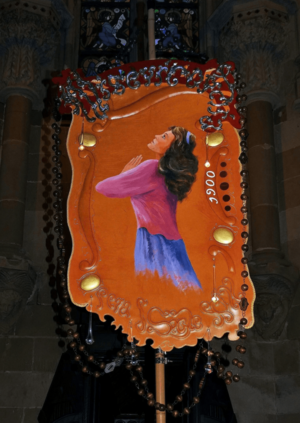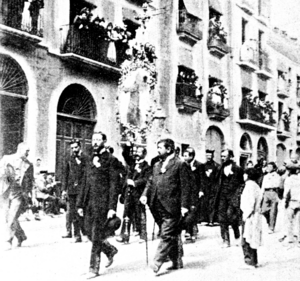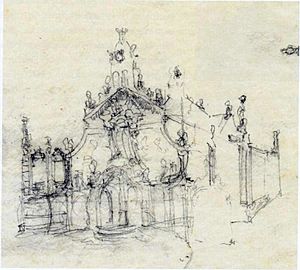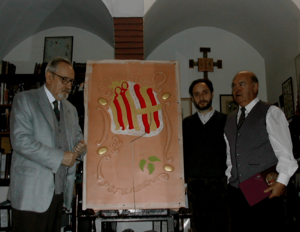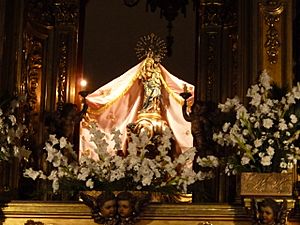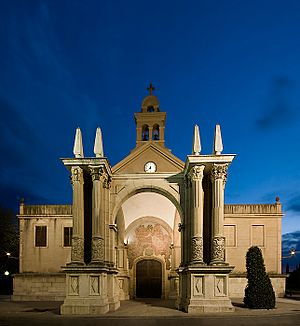Banner of Misericordia facts for kids
The banner of Misericordia (which means Mercy) was a special flag designed by the famous Catalan architect Antoni Gaudí. He created it for a big parade in 1900. This parade went to the Sanctuary of Misericordia in Reus. It was part of the celebrations for the Holy Year.
We know what the banner looked like from two photos. These pictures were published in a magazine called Semanario Católico de Reus in July 1900. The magazine also showed a photo of the parade itself. In that picture, you can see Gaudí walking with many other people. One person is carrying the banner.
Another issue of the same magazine described the banner. It even mentioned the materials Gaudí used to build it. The banner stayed at the sanctuary until July 1936. Sadly, it was destroyed during the Spanish Civil War.
Years later, from 2003 to 2007, a special project began. People wanted to make an exact copy of the banner. They studied the old photos very carefully. They used the same materials and building methods as Gaudí. This replica banner is now on display. You can see it in the crypt of the Sagrada Família Temple in Barcelona.
What the Banner Looked Like
The banner was like a flag. It was made of leather that had been shaped and had holes in it. It was roughly shaped like a trapezoid, standing tall. It had a front side and a back side.
The front side had a painting by Aleix Clapés. He was a painter and a friend of Gaudí. The painting showed a shepherdess named Isabel Besora praying. Tradition says she saw the Virgin Mary. Aleix Clapés also worked with Gaudí on other famous buildings. These include the Palau Güell and the Casa Milà.
The back side of the banner had the shield of Barcelona. It was painted in gold and silver. On top of this, there was a rose made of shiny platinum. This rose represented the city of Reus.
The banner was held up by a bamboo stick. This stick had metal decorations. At the very top of the stick was a small statue. It showed the Virgin of Misericordia (Mercy). She had her cloak spread out and was surrounded by angels. This statue was made of colorful aluminum. Above the Virgin, there was a cross and the name of Jesus.
There were also words on both sides of the banner. On the front, it said "Misericordia" at the top. At the bottom, it said "Per al segle XIX" (which means "For the 19th century"). These letters were carved from aluminum. The year "1900" was painted on, showing it was for the Holy Year.
On the back, it said "Barcelona" and "Reus" on the sides. "Misericordia" was at the top again. Below that, it said "Per a nantrus" ("For us" in a local Catalan accent).
A rosary made of aluminum and bronze beads wrapped around the whole banner. The inside frame that made the flag strong was also aluminum. All the materials were very light. This made it easy to carry the banner during the long parade. Gaudí's cousin, Jose Gaudí Pomerol, might have made the metal parts. He had a workshop in Barcelona.
What the Banner Meant
The banner told the story of the Virgin Mary appearing to the shepherdess Isabel Besora in 1592. This happened when a serious sickness was affecting the city. The story says that the Virgin told Isabel to light a candle on the church altar. The flame had to be so bright it would light up the city walls during a parade. If they did this, the sickness would end.
Every part of the banner showed this story. The painting of the girl praying was one example. The rose was another important symbol. The story says the Virgin left a rose mark on Isabel's cheek. This was to prove that the vision was real. The rose then became a symbol for the city of Reus. The rosary wrapped around the banner also showed prayer and faith.
The banner also showed the friendship between Barcelona and Reus. This was done by combining their city shields. In short, the banner was a way to honor the patron saint of Reus. It was also a celebration of the Holy Year in 1900.
Gaudí's Other Ideas for Reus
Reus is thought to be Gaudí's birthplace. However, it doesn't have many of his finished buildings. Gaudí did create a plan to fix up the front of the Sanctuary of Misericordia. He made this plan after the big parade in 1900. The sanctuary was built in the 1600s. It stands where Isabel Besora is said to have seen the Virgin Mary.
For reasons that are not fully clear, Gaudí's plan was never built. It seems there were problems with neighbors. Another architect started the work in 1915, but only the foundation was built.
Two of Gaudí's original drawings for this project are still kept. You can see them at the Museu Comarcal de Reus (Reus regional museum). These drawings show a fancy, Baroque-style front. It was similar to his other works, like Casa Calvet. He also planned a huge rosary along the road leading to the sanctuary.
In 1976, the city of Reus started building a copy of a fountain from Gaudí's Casa Vicens. The original fountain had been taken down in 1946. This new fountain was meant for a spot near the "Gaudí" neighborhood. But the work stopped in 1978. The unfinished fountain was later taken down in 2002.
Gaudí's plans for the banner and the sanctuary show his connection to Reus. There is a debate about where Gaudí was truly born. Some say Reus, others say Riudoms. His father's family was from Riudoms, and his mother was from Reus. These towns are only a few kilometers apart. Gaudí spent his childhood in both places. So, it's likely he felt a connection to both.
See also
 In Spanish: Estandarte de la Misericordia para niños
In Spanish: Estandarte de la Misericordia para niños
- Antoni Gaudí
- Modernisme
- Modernismo catalán (in Spanish)
- Reus
- Santuario de Misericordia (in Spanish)
- Isabel Besora (in Catalan)




